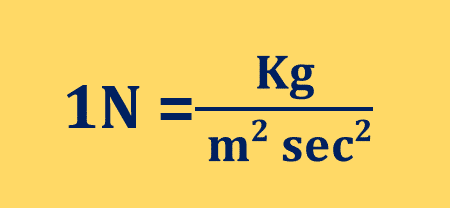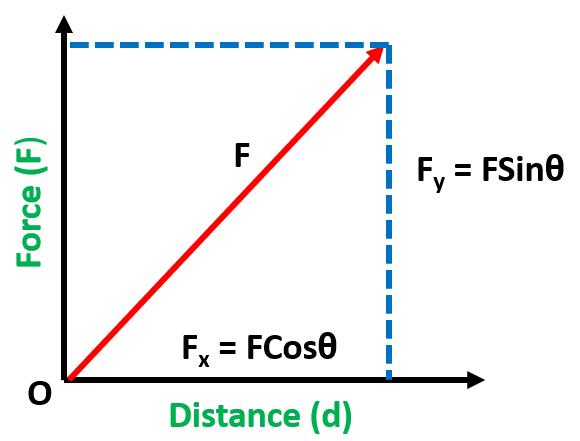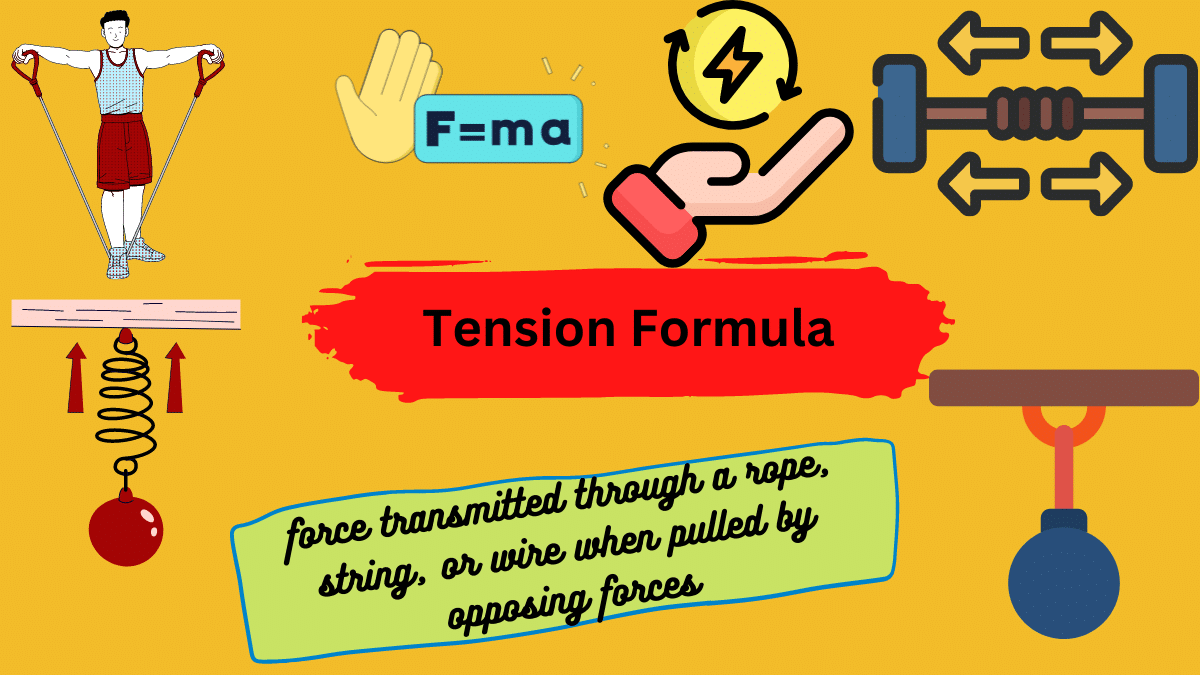Force definition: Force is an external agent capable of changing the state of rest or state of motion of a particular body. It can move or tend to move an object or it can stop or tend to stop an object. It is a vector quantity.
Some examples are listed below:
- When we apply force to a cart, we can either push or pull it. The push may move the cart, change its direction of motion, or stop the cart in motion.
- By pushing the knife’s sharp edge into the apple, we apply force to cut it.
- When something is squashed or stretched, it changes shape and pushes or pulls on the squashing or stretching object.
- When you ride your bike, the force of your foot pushes on the pedal.
- The force exerted by a magnet on a paper clip when the magnet attracts the paper clip.
- A person floats in calm water by using force.

Units of Force
- Newton
- Dyne (1 Newton = 100000 dynes)
- pound-force (1 Newton = 0.224 pound-force)

Table of Contents
How does Force work?
- Force can make a body that is at rest to move.
- It can stop a moving body or slow it down.
- Force can accelerate the speed of a moving body.
- It can also change the direction of a moving body along with its shape and size.
Can force be negative?
Force can be negative.
Force is a vector quantity and depends upon the direction in which we apply force.
Consider that we are applying force to an object but we aren’t able to move that object in the direction of the force. In this case, the object is applying a reaction force that is greater than the applied force. Therefore, the net force is negative.
Horizontal and vertical components of force
Consider a force (F) applied to an object. The force F is making an angle θ with the surface on which the body is moved as shown in the figure at left. The applied force F can be resolved into its perpendicular components Fx and Fy.
Fx = Fcosθ ——— (1)
Fy = Fsinθ ——— (2)
When Force and displacement are not parallel then only the x-component of force (Fx) causes the body to move on the surface.

Daily Life Examples of Force in Simple Words
A few examples of forces in daily life are:
- Magnetic Force – This is the force that arises between two magnets or a magnet and a piece of iron. For example, when you put two magnets together, they will either attract or repel each other depending on their orientation.
- Gravity is the force that pulls items towards the earth’s center. When you drop a ball, it falls to the ground due to the force of gravity.
- Friction is the force that opposes movement between two surfaces that are in contact. When you try to slide a book across a table, for example, the friction between the book and the table makes it difficult to move.
- Tension is the force transmitted through a rope, string, or cable when it is tightened. When you are on a swing, for example, the rope or chain that holds the swing is under tension.
- Air resistance is the force that opposes an object’s motion through the air.
Important Links
Kinetic Energy Formula
Energy-The Ability to do Work
The Spring Constant & Spring Force Concept
Relativistic Kinetic Energy| Easy Explanation
Types of Force with Examples
| Name | Symbol | Formula | Symbols | Applications | Examples |
|---|---|---|---|---|---|
| Force | F | F = m * a | F: force, m: mass, a: acceleration | Mechanics | Pushing a car, lifting weights, throwing a ball |
| Frictional force | f | f = μ * N | f: frictional force, μ: coefficient of friction, N: normal force | Mechanics | Friction, drag force, the tension in a string |
| Force of gravity | Fg | Fg = m * g | Fg: the force of gravity, m: mass, g: acceleration due to gravity | Gravity | Weight of an object, the force due to gravity |
| Centripetal force | Fc | Fc = (m * v^2) / r | Fc: centripetal force, m: mass, v: velocity, r: radius | Circular motion | Centripetal force in a roller coaster or a Ferris wheel |
| Spring force | Fspring | Fspring = k * x | Fspring: spring force, k: spring constant, x: displacement | Spring force | Compression or extension of a spring |
| Torsional force | Ft | Ft = τ / r | Ft: torsional force, τ: torque, r: radius | Torsional force | Twisting or rotating an object around an axis |
| Buoyant force | Fbuoy | Fbuoy = ρ * g * V | Fbuoy: buoyant force, ρ: fluid density, g: acceleration due to gravity, V: volume | Buoyancy | Force acting on an object in a fluid |
| Electromagnetic force | Fm | Fm = (k * q1 * q2) / r^2 | Fm: electromagnetic force, k: Coulomb’s constant, q1 and q2: charges, r: distance | Electromagnetic force | Attraction or repulsion between charged particles |
| Frictional force | Ffr | Ffr = μ * N | Ffr: frictional force, μ: coefficient of friction, N: normal force | Frictional force | Opposing motion of an object sliding on a surface |
Force and First Law Of Motion
According to the first law of motion, a body continues its state of rest or uniform motion in a straight line provided no net force acts on it. This part of the law is true as we observe that objects do not move by themselves unless someone moves them. Since Newton’s first law of motion deals with the initial property of matter Newton’s first law of motion is also known as the law of inertia.
Examples of the First Law of Motion
- As long as no net force acts on a book lying on a table, it remains at rest.
- A rolling ball on rough ground comes to a halt sooner than one rolled on smooth ground. It’s because the rough surface creates a lot of friction. If there was no force to oppose a body’s motion, the body would never stop moving.
Newton’s Second Law of Motion
Newton’s second law of motion applies when a net force acts on a body. It specifies “When a net force acts on a body, it causes the body to accelerate in the direction of the net force. This acceleration is proportional to the net force acting on the body and inversely proportional to its mass “.
Mathematical Form of Newton’s Second Law
If a force produces an acceleration in a body of mass m the
acceleration (a) ∝ Force (F)
acceleration ∝ 1/m
Combing equations 1 and 2
a ∝ F/m Therefore, a =kF/m
Where k is a proportionality constant. In SI units, the value of k is 1.
When m =1kg, F=1N then a =1m/sec.
a = F/m so F =ma
Newton’s Third Law of Motion
To every action, there is always an equal but opposite reaction.
Explanation of Newton’s Third law of motion
Newton’s third law of motion deals with a body’s reaction to a force acting on it. Let body A exert a force on body B, and body B reacts by exerting a force on body A. The reaction force is the force exerted by body B on body A.
According to this law, the action is always accompanied by a reaction force and the two forces must always be equal and opposite. Action and reaction forces act on different bodies.
Related Links
Mechanical Energy| 7 Examples
Light Energy| 5- Easy Examples
Electromagnetic Force- An Overview
Momentum Equation| Examples
Summary
- Force is a physical quantity defined as a push or pull on an object.
- The SI unit of force is Newton (N), equivalent to kg * m/s^2.
- There are various types of forces, including frictional force, the force of gravity, centripetal force, spring force, applied force, torsional force, buoyant force, and electromagnetic force.
- The applications of force are numerous, ranging from mechanics to gravity, circular motion, spring force, applied force, torsional force, buoyancy, and electromagnetic force.
- Examples of force in action include pushing a car, lifting weights, throwing a ball, friction, drag force, tension in a string, the weight of an object, centripetal force in a roller coaster or a Ferris wheel, compression or extension of a spring, pushing or pulling an object by an external force, twisting or rotating an object around an axis, force acting on an object in a fluid, and attraction or repulsion between charged particles.
Consider that we are trying to move an object but we aren’t able to move that object in the direction of the force. In this case, the object is applying a reaction force that is greater than the applied force. Therefore, the net force is negative.
Since force is directly proportional to acceleration. so negative acceleration means negative force
Possible Exams Questions
- What is force and how is it measured?
- What is the SI unit of force and what is its definition?
- What are the different types of forces and what are their applications?
- What is Newton’s Second Law of Motion and how is it related to force?
- What is friction and how does it affect the motion of objects?
- What is centripetal force and what is its role in circular motion?
- What is gravitational force and how does it affect the motion of objects?
- What is electromagnetic force and what are some of its applications?
- How can we calculate the force in different situations?
- What are some common examples of force in everyday life?
Related Links
Tensile Stress – Introduction, Formula, SI Unit, and FAQ
Stress in Physics| Definition and Easy Examples
Work-Formula, Definition, & Units
Work-Energy Theorem
Gravitational Potential Energy (w=mgh)| Easy Examples
- BCl3 Lewis Structure in four simple steps - November 1, 2023
- PH3 Lewis Structure in four simple steps - October 8, 2023
- PF3 Lewis structure in four simple steps - September 24, 2023



